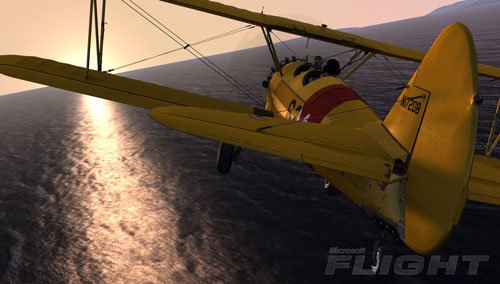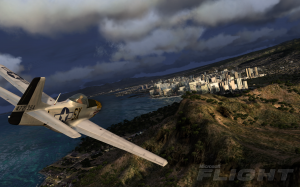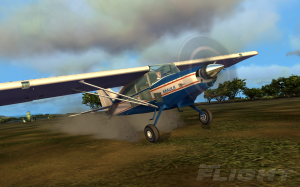
Before we start, there’s something I need to confess. When it comes to flight simulators, I’m a complete novice. Fear not though, because Microsoft Flight is intended to get everyone in the air, “whether you are a casual gamer who has always wanted to fly, or an experienced pilot who wants to test your skills”. The question is, can Microsoft’s free-to-play simulator really help rookies like myself get airborne, while maintaining enough depth to satisfy veteran pilots?
Microsoft Flight is a new approach to packaging a flight simulator, from a company with a grand tradition in this area. The game is presented as a free download, giving access to the big island of Hawaii, along with two starter planes with which to explore the skies. No expensive flight stick is needed to play the game, although it is recommended for more advanced aerobatic manoeuvres, and I managed throughout with just a mouse and keyboard.
Setting Flight in Hawaii was a minor masterstroke by Microsoft, as the island offers a substantial variety of scenery and locations, while not being too large as to be daunting to newcomers. The main island offers 13 air strips, which range from small dirt runways, nestled in among the trees, to large commercial affairs. Alongside these, you are free to touch down anywhere that seems flat enough. You can even land in the sea, thanks to the amphibious capabilities of the slow but stable starter plane, the Icon A5.
Landing your plane successfully, on land or water, accounts for a large proportion of the initial challenges and missions in Flight. My first faltering approaches at fairly decent sized runways were pretty awful, and resulted in me overshooting, undershooting, and even forgetting to engage my undercarriage on one occasion. The game wouldn’t let me fail indefinitely though, and verbal prompts and visual cues helped me get back on track.
Eventually I was touching down with what seemed to be a decent success ratio, even on the tiny dirt runways hidden away in the Hawaiian countryside.
The challenges
In addition to the numerous landing challenges on offer, Flight likes to gauge your ability at negotiating glowing rings and picking up virtual trinkets in the game world. My first attempt at a Challenge Course mission, which involves flying through a sequence of hoops in the correct order, resulted in a quite exhilarating descent through a tree-lined valley, towards the ocean. There are three such challenge courses in the free version of Flight, along with two Gold Rush challenges, which task you with collecting 25 rings from a given location within an allotted time.
These challenges are a clear attempt by Microsoft to engage an audience that would not traditionally be found playing flight simulation games. Though many veteran pilots may object to their inclusion in Flight, I found them engaging, challenging, and perfect for a 10-minute blast on the game. Buzzing past rooftops in an open cockpit plane is always fun, and having glowing collectibles as justification for doing is a welcome move.
The freedom of Free Flight
Despite the short blasts of fun that the challenges offer, the feeling of discovery and exploration in Flight is better represented by the Free Flight mode, which has been augmented here by the addition of “aerocaches”. These are small, glowing objects placed in different parts of the island, and their discovery and collection, can either be by happy accident or the end result of a planned excursion. Swooping under a bridge to collect an aerocache was hugely satisfying, as was climbing over 14 000ft to the highest point on the island, and this guided exploration, more than anything, represents what Flight does best.
Free Flight mode is available from any of the 13 airstrips, and the weather conditions, seasons and time of day can all be quickly altered to give a diverse range of flying experiences. Taking off in a thunderstorm with a strong prevailing wind proved impossible in the Icon A5, and resulted in some hilarious false starts. The Boeing PT-17 Stearman, on the other hand, coped admirably with bad weather, and taking to the skies at dusk with rain lashing down and a red glow dimly visible on the horizon, was a surprisingly beautiful experience.
 In addition to user-defined flying conditions, there are a number of flight control assistance options in Flight, which can be switched on and off, to help newcomers or enhance the experience of veteran pilots. These options are turned on automatically at launch, but even as a relative rookie to the genre, I found myself switching some of them off after a few hours, which actually gave the game a more satisfying feel.
In addition to user-defined flying conditions, there are a number of flight control assistance options in Flight, which can be switched on and off, to help newcomers or enhance the experience of veteran pilots. These options are turned on automatically at launch, but even as a relative rookie to the genre, I found myself switching some of them off after a few hours, which actually gave the game a more satisfying feel.
Forgiving hardware requirements
My somewhat aging PC coped well with Flight on low and medium graphics settings, but the frame rate dropped significantly with everything set to high. However dense or detailed the scenery becomes on the ground, though, the sky always remains the star of the show, with the variety of weather conditions and times of day available offering players some gorgeous vistas, even on low settings. In this respect Microsoft has done an admirable job of balancing graphical performance with accessibility for a wider audience.
These have made their way onto both lists. Personally, I really enjoyed the challenges in Flight, but I can see how some flight simulation veterans could be upset at Microsoft’s addition of arcade style trappings to its game. Basically, you’re either going to love or hate this almost Pilotwings-like approach to conquering the skies. Thankfully if you hate the challenges then you can simple ignore them, and instead immerse yourself in Free Flight mode.
Empty skies and ghost towns
Graphically speaking, Microsoft Flight is a mixed bag. In what is supposed to be an accurate representation of Hawaii, it includes most major landmarks, roads and geographical features in some detail. On the other hand, there is no life on the island, be that pedestrians, traffic, animal life or even AI-controlled planes. The only indications of habitation are your occasional passengers, playing their ukeleles, craving hamburgers at distant airports and making thoughtful comments such as, “This is cool — we’re flying!”
 Entering the multiplayer aspect of the game does result in other planes sharing your airspace, with up to 16 players able to play and communicate on one server. I found it hard to discover a busy game though, mostly just meeting one other pilot at a time.
Entering the multiplayer aspect of the game does result in other planes sharing your airspace, with up to 16 players able to play and communicate on one server. I found it hard to discover a busy game though, mostly just meeting one other pilot at a time.
Less-than-spectacular crashes
Though crashing your plane is definitely an undesirable outcome in Flight, it never proves fatal, and is rarely dramatic. Even heading straight for the upstairs window of a house at 120 knots will result in you gently bouncing over the roof, spinning a few times, before ending up in the back garden. On more than one occasion I picked up points for aerobatics, as my plane spun helplessly but delicately down a mountainside. It is a little disappointing that such failures are represented with so little drama, but I suppose screams, breaking glass and broken bones are not the face of aviation that Microsoft wants to present.
Costly DLC
Opening up the flying experience to all-comers is definitely top of Microsoft’s agenda for Flight, and making the game free, with a relatively low hardware entry point, certainly supports this aim. After playing the game for a week though, the limitations of what is actually being given away here do become apparent.
With four introductory missions under my belt, nine landing challenges completed, five other challenges undertaken and 13 aerocaches discovered, there was nothing much left for me to do. Each airport has a jobs board, which can be accessed on foot, or from the in-game menu, but any mission requiring cargo space is inaccessible with only the two starter planes sitting in the hanger. Earning XP allows you to alter the paintwork on these planes, but any additional planes must be purchased with real money.
Buying the Maule-M-7-260C Orion would give you the cargo space necessary to take on more jobs, but this plane costs US$14,99 to unlock. The second plane available to purchase at present is the P-51 Mustang, a legendary warplane from World War 2, known for its speed and maneuverability, but not for its storage space. This will set you back a slightly more reasonable $7,99.
Beside these individual planes, Microsoft is selling access to the rest of the Hawaiian island chain for $19,99. This is dubbed the Hawaiian Adventure Pack, and it opens up new islands, along with associated challenges and one extra plane — the Vans RV-6A. Again, this plane doesn’t have the storage space required to perform cargo missions, so you are back to the problem of forking out $15, just to be able to access all job types, even when buying the Adventure Pack.
The Hawaiian Adventure Pack is the first of what Microsoft says will be many such add-ons for Microsoft Flight. The company has just announced an Alaska pack, which looks visually stunning, but does raise concerns about how much maintaining full access to Flight will cost in the long run. Buying Alaska, Hawaiian Adventure and the Maule aircraft looks likely to be a $55 proposition, and at that point you are approaching full retail price, with more content set to appear on the horizon.
Conclusion
As an introduction to flight simulation, Microsoft Flight does a sterling job. It is immediately accessible and offers a gentle but genuine challenge. Veteran pilots may find its leaning towards arcade-type challenges a bit of a turn off at first, but flight stick compatibility, a versatile free flight mode, and aerocache hunting all indicate the presence of a deeper game with lasting appeal.
The free content on offer is generous, but on completing all available challenges and missions you may be left feeling that you have been playing an extended demo all along. The decision on whether you board Flight for the long haul will largely be determined by your willingness to embrace Microsoft’s payment model, which is certainly interesting, but could turn out to be a costly long term proposition. — Dan Crawley, VentureBeat![]()
- Subscribe to our free daily newsletter
- Follow us on Twitter or on Google+ or on Facebook
- Visit our sister website, SportsCentral (still in beta)




